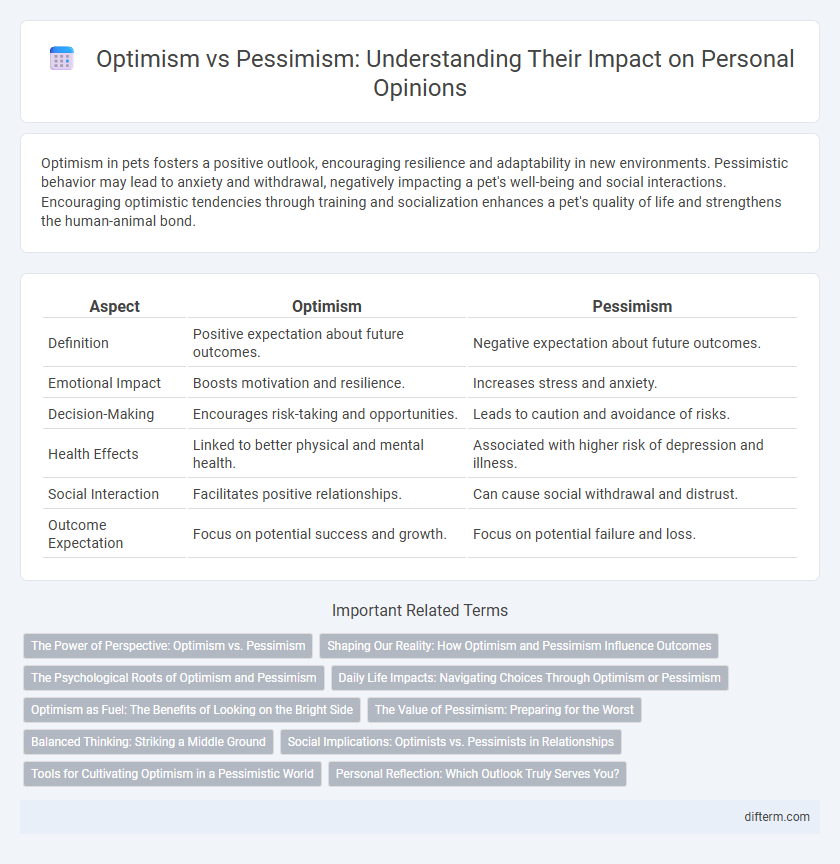Optimism in pets fosters a positive outlook, encouraging resilience and adaptability in new environments. Pessimistic behavior may lead to anxiety and withdrawal, negatively impacting a pet's well-being and social interactions. Encouraging optimistic tendencies through training and socialization enhances a pet's quality of life and strengthens the human-animal bond.
Table of Comparison
| Aspect | Optimism | Pessimism |
|---|---|---|
| Definition | Positive expectation about future outcomes. | Negative expectation about future outcomes. |
| Emotional Impact | Boosts motivation and resilience. | Increases stress and anxiety. |
| Decision-Making | Encourages risk-taking and opportunities. | Leads to caution and avoidance of risks. |
| Health Effects | Linked to better physical and mental health. | Associated with higher risk of depression and illness. |
| Social Interaction | Facilitates positive relationships. | Can cause social withdrawal and distrust. |
| Outcome Expectation | Focus on potential success and growth. | Focus on potential failure and loss. |
The Power of Perspective: Optimism vs. Pessimism
Optimism fuels resilience and enhances problem-solving by framing challenges as opportunities, aligning with studies linking positive outlooks to improved mental and physical health. Pessimism, while often criticized, sharpens critical thinking and risk assessment, providing a realistic counterbalance that can prevent complacency. The power of perspective lies in balancing optimism's motivational drive with pessimism's cautionary insights to navigate complex decisions effectively.
Shaping Our Reality: How Optimism and Pessimism Influence Outcomes
Optimism significantly shapes reality by promoting proactive behaviors and resilience, leading to improved problem-solving and greater success in achieving goals. Pessimism, while often viewed negatively, can enhance caution and risk assessment, potentially preventing reckless decisions. Balancing these outlooks allows individuals to navigate challenges effectively, optimizing outcomes through a realistic yet hopeful perspective.
The Psychological Roots of Optimism and Pessimism
The psychological roots of optimism and pessimism stem from cognitive biases and brain function, where optimists typically exhibit a stronger activity in the left prefrontal cortex associated with positive expectations. Early life experiences and learned behaviors shape these outlooks, influencing how individuals perceive and react to adversity. Neurochemical factors, such as dopamine regulation, also play a crucial role in fostering optimistic or pessimistic tendencies.
Daily Life Impacts: Navigating Choices Through Optimism or Pessimism
Optimism in daily life encourages proactive decision-making and resilience, often leading to improved mental health and greater goal attainment. Pessimism can result in cautious behavior, potentially preventing risks but also limiting opportunities and fostering stress. Understanding these impacts helps individuals navigate choices by balancing hopeful expectations with realistic assessments.
Optimism as Fuel: The Benefits of Looking on the Bright Side
Optimism drives resilience by fostering a positive mindset that enhances mental health and encourages proactive problem-solving. Studies reveal that optimistic individuals experience lower stress levels and improved cardiovascular health, highlighting the tangible benefits of maintaining a hopeful outlook. Embracing optimism fuels motivation, increases longevity, and promotes overall well-being by reinforcing adaptive coping strategies.
The Value of Pessimism: Preparing for the Worst
Pessimism plays a crucial role in risk management by encouraging thorough preparation for potential challenges and uncertainties. It sharpens critical thinking and fosters contingency planning, ensuring individuals and organizations are better equipped to handle adverse outcomes. Embracing pessimism can ultimately lead to more resilient strategies and realistic expectations in both personal and professional contexts.
Balanced Thinking: Striking a Middle Ground
Balanced thinking harmonizes optimism and pessimism by integrating realistic hope with pragmatic caution, enhancing decision-making and emotional resilience. Emphasizing evidence-based assessments and adaptive perspectives allows individuals to navigate uncertainty effectively while maintaining motivation and preparedness. This middle ground fosters mental well-being and promotes strategic actions in complex situations.
Social Implications: Optimists vs. Pessimists in Relationships
Optimists tend to foster stronger social connections through positive communication and resilience, which enhances trust and cooperation in relationships. Pessimists may struggle with social interactions due to negativity bias, leading to increased conflict and social withdrawal. Understanding these social implications helps in developing strategies for more effective interpersonal dynamics and emotional support.
Tools for Cultivating Optimism in a Pessimistic World
Practicing gratitude journals and engaging in positive visualization are powerful tools for cultivating optimism in a pessimistic world. Cognitive-behavioral techniques, such as reframing negative thoughts, enhance resilience and foster a more hopeful outlook. Regular mindfulness meditation improves emotional regulation, allowing individuals to maintain optimism amid challenges.
Personal Reflection: Which Outlook Truly Serves You?
Optimism fuels resilience by encouraging a growth mindset that sees challenges as opportunities for learning, while pessimism can act as a protective mechanism, preparing you for possible setbacks. Reflecting on your dominant outlook reveals whether hopeful anticipation or cautious realism better supports your mental well-being and decision-making processes. Ultimately, balancing optimism with practical awareness creates a personalized approach that aligns with your goals and emotional needs.
optimism vs pessimism Infographic

 difterm.com
difterm.com